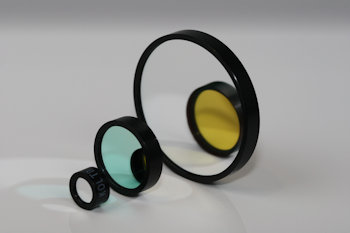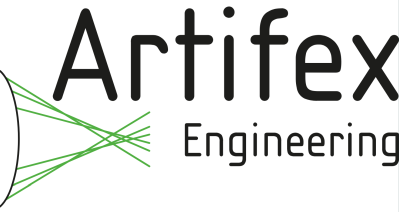interference filters (original) (raw)
Definition: optical filters based on interference effects
- optical elements
- optical filters
* interference filters
* dichroic mirrors
* rugate filters
* etalons
* Fabry–Pérot interferometers
* diffraction gratings
* birefringent tuners
* acousto-optic tunable filters
* cold mirrors
* hot mirrors
* arrayed waveguide gratings
* Lyot filters
* neutral density filters
* monochromators
* (more topics)
- optical filters
Related: interferenceoptical filtersdielectric mirrorsFabry–Pérot interferometers
Page views in 12 months: 923
DOI: 10.61835/mpw Cite the article: BibTex BibLaTex plain textHTML Link to this page! LinkedIn
Content quality and neutrality are maintained according to our editorial policy.
📦 For purchasing interference filters, use the RP Photonics Buyer's Guide — an expert-curated directory for finding all relevant suppliers, which also offers advanced purchasing assistance.
Contents
What are Interference Filters?
Interference filters are optical filters which are based on exploiting optical interference effects — in contrast to absorbing filters, which utilize wavelength-dependent absorption.
Most interference filters are dielectric multilayer mirrors, where the total reflected light arises from the interference of reflections at several or even many optical surfaces between different thin layers; the same holds for the transmitted light. See the article on dielectric mirrors for more details on fabrication and the operation principle.
There are also multilayer filters containing both dielectric and metal films. With that technology, one can work with fewer layers (e.g. just two metal films with a dielectric film in between), still obtaining substantial reflections, but the absorption losses are substantially higher than for purely dielectric mirrors.
Some interference filters exploit the principle of Fabry–Pérot interferometers. This is possible with monolithic dielectric or metal/dielectric mirror structures, but also with composite structures, involving two separate mirror devices, which are in most cases rigidly fixed to each other such that the spacing, which is essential for interference effect, is accurately maintained.
The function of an interference filter can be that of a bandpass filter, notch filter, high-pass or low-pass filter, for example, depending on the used design type. For example, Fabry–Pérot designs naturally lead to bandpass characteristics in transmission and notch filter characteristics in reflection. High- and low-pass filters can be designed as somewhat modified Bragg mirrors. The optimization of interference filter designs often involves numerical multilayer thin-film software.
See the article on optical filters for further details.
General Properties
Some general properties of interference filters are briefly summarized in the following:
- Through their design, one may realize a wide range of properties. As a substantial number of layer pairs are usually used, there are many degrees of freedom.
- In contrast to absorbing filters, interference filters can usually be operated with relatively high optical intensities without being damaged.
- There can be a significant temperature dependence on the detailed optical properties, since the temperature affects the refractive indices.
- Because longer propagation lengths provide larger phase differences even for small differences in optical wavelength, often thicker devices are required for improved wavelength resolution. However, resonance effects can substantially improve resolution without using a large thickness.
- The filter characteristics substantially depend on the angle of incidence of the input light because that influences the optical phase differences between reflections from different interfaces. Generally, larger angles of incidence lead to smaller phase differences, although the opposite may be expected [1]. As a result, spectral features tend to move to shorter wavelengths as the angle of incidence is increased (see Figure 1).

Figure 1: The reflectivity spectrum of a Bragg mirror for different incidence angles from normal incidence (red) up to 60° (blue) in steps of 10°. For larger incidence angles, the spectral features move towards shorter wavelengths. The diagram has been produced with the RP Coating software.
Frequently Asked Questions
This FAQ section was generated with AI based on the article content and has been reviewed by the article’s author (RP).
What is an interference filter?
An interference filter is an optical filter that works by exploiting optical interference effects. Unlike absorbing filters, it does not rely on wavelength-dependent absorption and is typically made of multiple thin dielectric layers.
How do interference filters work?
An interference filter functions by creating interference between light beams reflected at the interfaces of its multiple thin layers. The superposition of these reflections determines the total reflected and transmitted light, effectively filtering the spectrum.
What are the advantages of interference filters over absorbing filters?
The main advantage of interference filters over absorbing filters is their ability to handle high optical intensities without being damaged. They also offer great design flexibility for a wide range of properties.
How does the angle of incidence affect an interference filter?
The performance of an interference filter strongly depends on the angle of incidence. Typically, as the angle of incidence increases, the spectral features of the filter shift toward shorter wavelengths.
Suppliers
Sponsored content: The RP Photonics Buyer's Guide contains 28 suppliers for interference filters. Among them:
⚙ hardware
Knight Optical have a vast range of mounted interference bandpass filters available from our stock catalogue. We have narrow, standard and broadband options with wavelengths centred in the UV, visible and NIR regions. We offer specific ANPR filters with NIR centre wavelengths which correspond to commonly used LED wavelengths (740 nm, 850 nm, 870 nm and 940 nm). We also offer fluorescence filter sets which include excitation and emission interference bandpass filters which work with common fluorophores. As well as our large stock range, we also offer custom interference filters to suit your application.
⚙ hardware
Artifex Engineering offers custom interference filters for use in the UV, VIS and IR. Bandpass filters, notch filters, highpass or lowpass filters are available and can be cut to any shape. To reduce the number of layers, absorption filters (color filters) can be combined with a dielectric coating. Black anodized aluminium rings may be provided for ease of mounting. Visit our product page for more information. We look forward to your inquiry.
⚙ hardware
LASEROPTIK can design and fabricate a wide range of interference filters for standard and special applications.
⚙ hardware
We design and manufacture a wide range of custom interference filters such as bandpass, long/short pass filters and notch filters across a range of 300 nm — 6000 nm. We have worked on many projects over the years including applications such as gas detection, environmental monitoring, machine vision and many more.
Bibliography
(Suggest additional literature!)
Questions and Comments from Users
Here you can submit questions and comments. As far as they get accepted by the author, they will appear above this paragraph together with the author’s answer. The author will decide on acceptance based on certain criteria. Essentially, the issue must be of sufficiently broad interest.
Please do not enter personal data here. (See also our privacy declaration.) If you wish to receive personal feedback or consultancy from the author, please contact him, e.g. via e-mail.
By submitting the information, you give your consent to the potential publication of your inputs on our website according to our rules. (If you later retract your consent, we will delete those inputs.) As your inputs are first reviewed by the author, they may be published with some delay.
 general optics
general optics





